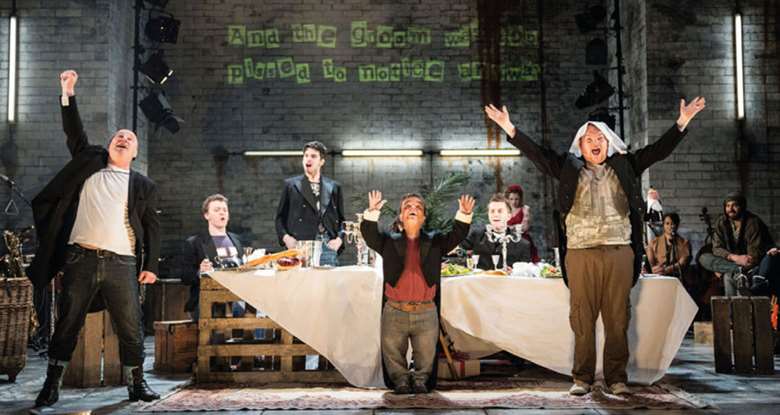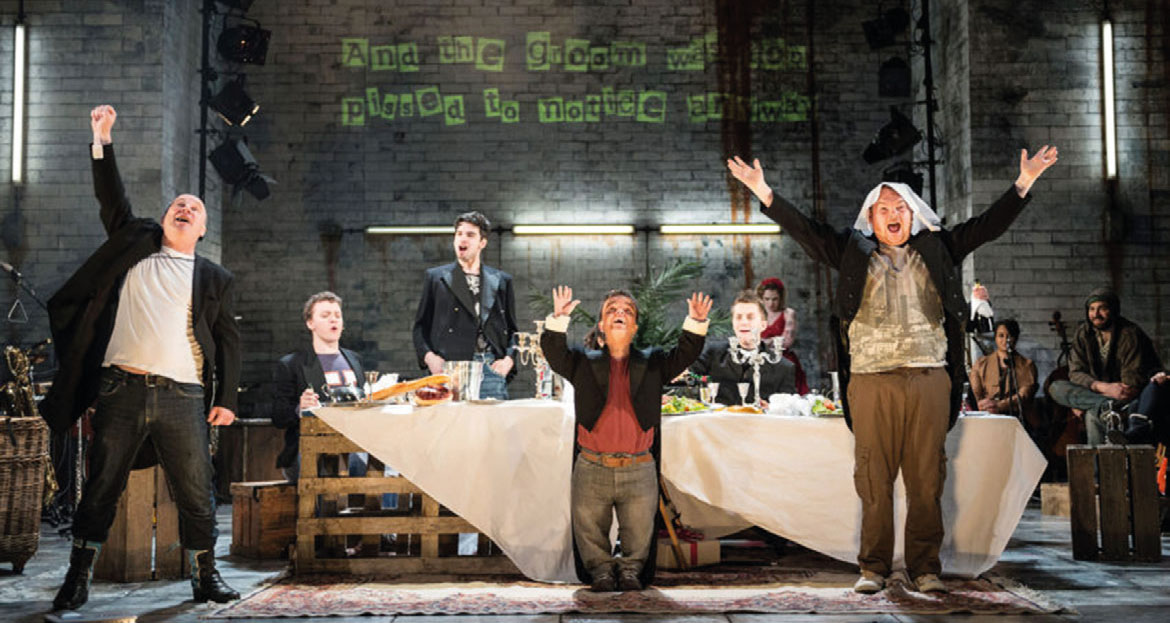The Threepenny Opera
Bertolt Brecht, Kurt Weill, Elisabeth Hauptmann, Anja Hartl
Monday, May 1, 2023
Each issue of D&T we bring you a teacher or academic’s guide to a play for study with your students. This issue, Anja Hartl introduces The Threepenny Opera

HARRY ELLETSON
With its colourful characters, humorous plot and memorable music, The Threepenny Opera (1928) is one of Bertolt Brecht’s most successful and most popular plays. Set in Victorian London, it portrays the tumultuous life of Macheath, an amoral bandit who marries Polly Peachum, the daughter of an unscrupulous entrepreneur. Because the marriage endangers his business, Mr Peachum wants to have Mac hanged. As the line between law and crime blurs, the play couples entertainment and critique to stage a biting satire of social norms, resonating strongly with our contemporary moment.
Themes
In the world of Threepenny and beyond, ‘money rules the world’, as Mrs Peachum fittingly states. Mr Peachum’s company capitalises on other people’s misery: his employees disguise themselves as beggars to raise money by evoking sympathy from passers-by. When his daughter announces her marriage, Mr Peachum is less concerned about her wellbeing than about his economic gain as he fears competition from Mac, the ruthless and shameless criminal. Even though Macheath is a bandit from the underworld, he is depicted as an ordinary businessman. Indeed, in Threepenny, society is ruled by criminals and prostitutes, with most of the action displaced to the street, the prison, and the brothel. Entrepreneur and gangster therefore become interchangeable as distinctions between moral and amoral, high and low, respectable and corrupt dissolve.

© HARRY ELLETSON
Graeae Theatre’s 2014 production of The Threepenny Opera
The play’s depiction of rampant capitalism, exploitation and corruption is also connected to its treatment of women. In the opera, marital life is closely aligned with prostitution; love is not a genuine emotion but a business affair; and the characters try to manipulate each other’s feelings. The female characters are objectified in this patriarchal economic system, while relationships are exploitative and violent in nature. In the era of #MeToo, the play’s sexual politics may be perceived as problematic and provocative. While Threepenny offers a springboard for discussions about the role of women, it also requires careful consideration of the play’s feminist potential today.
Brechtian Epic Theatre
Threepenny marks a watershed moment in Brecht’s career and in his approach to theatre. He used the play as a testing ground to experiment with new dramaturgical and technological devices to develop a type of theatre capable of social critique. Brechtian theatre aims to show us that the world can be changed and assigns spectators an active role in this transformation, inviting them to critically engage with the play (rather than to feel with the characters). In Threepenny, many typical means of epic theatre are deployed, such as visible staging machinery and the inclusion of narrative and musical elements. In the original production at the Theater am Schiffbauerdamm in Berlin, for example, the members of the orchestra were not hidden away in the pit but were visible on stage. A half-height curtain made it possible for spectators to witness scene changes, and signs were used to announce songs and scene titles. Reading Brecht’s essays Notes on The Threepenny Opera and Notes on the Opera Rise and Fall of the City of Mahagonny alongside the play is instructive when encouraging students to imagine ways of staging Threepenny that resonate with Brecht’s ideas about epic theatre. A comparison with recent productions – for instance, the National Theatre’s 2016 staging or the Berliner Ensemble’s in 2021 – can provoke lively discussions about the topicality of the play and of Brecht’s theatre theory.
Music
Above all, Threepenny has become so popular because of its music. The songs are widely recognised outside of the context of the production and have been interpreted by famous singers, such as Louis Armstrong, Ella Fitzgerald, Robbie Williams and Michael Bublé. The musical element was not meant to entertain, though, but to criticise. In fact, Brecht’s work is an adaptation of John Gay’s 18th-century The Beggar’s Opera, a satire that breaks with operatic conventions, with beggars, thieves and whores exposing the hypocrisy of the ruling classes. In a similar vein, Brecht uses the genre of the opera as a symbol of the very principles of society he sought to change and parodies it. Music and lyrics are therefore very different from traditional operatic styles. Exploring the melodies, texts and different interpretations of the songs is a rewarding and fun activity in the classroom to discuss how music is used by Brecht to comment on the action.
Resources
-
David Barnett’s Brecht in Practice (Bloomsbury Methuen Drama Engage, 2014) provides an excellent introduction to Brecht’s theatre theory and practice.
-
The most significant of Brecht’s own writings are included in the collection Brecht on Theatre (ed. Marc Silberman, Steve Giles and Tom Kuhn, Bloomsbury Methuen Drama, 2014).
-
The new Methuen Drama Student Edition of The Threepenny Opera (ed. Anja Hartl, 2022) contains a useful introduction and further material on the play.
-
The National Theatre, which has staged a new version of The Threepenny Opera by Simon Stephens in 2016, has created a learning guide for teachers: http://bloomsbury.com/media/e4qnnpdr/nt_thethreepenny-opera-learning-guide_rs.pdfbloomsbury.com/media/e4qnnpdr/nt_thethreepenny-opera-learning-guide_rs.pdf

